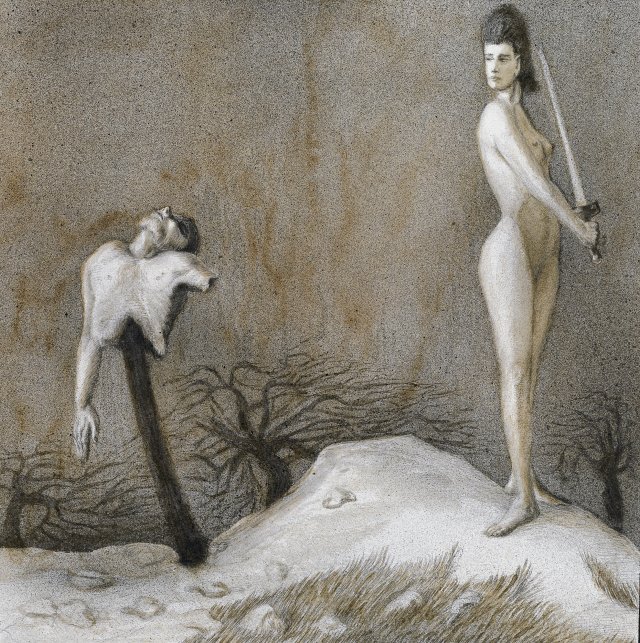Alfred Kubin: The Egg, approx. 1901/02, 15.8 × 23.8 cm, ink on paper
Photo: ALBERTINA, Vienna © Eberhard Spangenberg, Munich/Bildrecht, Vienna 2024
It is undeniable that everything Austrian triggers a strange fascination in Germany, especially in the Prussian part of it. The Austrian is as German as you’ve perhaps never been here. People look with excitement at the political developments in the Alpine republic – with the horrible idea in the back of their minds that the right-wing majorities in Austria are only a harbinger for the right-wing majorities here.
And all the polite, courtly demeanor, the pompous, the superficially shiny, much admired, is of course just a nice appearance. Artists in Austria have always countered this more mercilessly than elsewhere. In literature, music and visual arts. The film director Ulrich Seidl, for example, perhaps the greatest Austrian visual artist of today, shows us the less well-illuminated sides and their protagonists: the old and new Nazis, the perverts, the sex tourists, the outcasts.
In a way, Seidl is continuing a project that Egon Schiele stood for a good 100 years ago. Or Alfred Kubin, to whom a recently opened exhibition at the Albertina Modern is dedicated, which goes by the telling title “The Aesthetics of Evil” and which can be viewed until the new year.

Alfred Kubin: Battle Festival, around 1900, 22.8 × 22.9 cm, ink on paper
Photo: Albertina, Vienna © Eberhard Spangenberg, Munich/Bildrecht, Vienna 2024
It is tempting to understand Alfred Kubin’s dark work as the product of a damaged biography. This is also suggested by the catalog that was published for the exhibition – which is definitely worth reading and looking at – as well as the dramaturgy of the Vienna exhibition. In her text – half CV, half psychogram – the curator Elisabeth Dutz provides the relevant keywords: growing up initially without a father; the early death of the mother, then the stepmother; a childhood without care; an abusive sexual relationship of which he becomes a victim in late childhood. He will hardly ever find the happiness in life that he did not encounter as an adolescent either later on.
Life as torture is not a new motif in art history. But Kubin is the one who edited it almost obsessively. His ink drawings on the subject of birth in particular bear witness to this. Entering life always means being doomed to die. In Kubin’s case, the children rob their birthing mothers of their last vital forces. Children are born lifeless. Women become child murderers.
nd.DieWoche – our weekly newsletter

With our weekly newsletter nd.DieWoche look at the most important topics of the week and read them Highlights our Saturday edition on Friday. Get your free subscription here.
This shows more than just an apocalyptic social mood around 1900. Kubin shows no mercy in his fine-grained drawings; The theme of death apparently dominates him more than he is able to master it artistically. We are not only dealing with an aesthetic of evil, but also of the ugly and the horrible.
Other recurring motifs – only works from Kubin’s early work up to 1904 are presented – are organized into further comprehensible groups of works in this exhibition. War and torture play a role, but so do the ravages of pandemics. Points of connection of pictorial nature to the present are offered to the viewer, but without being unpleasantly intrusive or even pedagogically prescribed by the curator.
The most impressive part of the exhibition is certainly Kubin’s depictions of women. Whether portrayed as perpetrators of violence or as victims of violence, cold distance to the female gender is evident in every case. His female characters do not avoid the cliché, but exaggerate the cliche to such an extent that what is depicted has an impact for a long time. What Kubin creates – and we are truly dealing with creatures here! – is not a battle of the sexes, but a war of the sexes. Some of his images also imply its fatal outcome.
If you’re looking for something more uplifting, you might find what you’re looking for in the Leopold Museum, not too far away, which houses a collection of works by Gustav Klimt. With Alfred Kubin, however, beauty cannot be had without horror.
Alfred Kubin: “The Aesthetics of Evil”, until January 25th, Albertina Modern, Vienna.
An extensive catalog volume has been published to accompany the exhibition: Alfred Kubin: The Aesthetics of Evil, ed. v. Elisabeth Dutz, Hatzje Cantz, 232 pages, born, €44.
Become a member of the nd.Genossenschaft!

Since January 1, 2022, the »nd« will be published as an independent left-wing newspaper owned by the staff and readers. Be there and support media diversity and visible left-wing positions as a cooperative member. Fill out the membership form now.
More information on www.dasnd.de/genossenschaft
link sbobet judi bola online sbobet88 link sbobet
